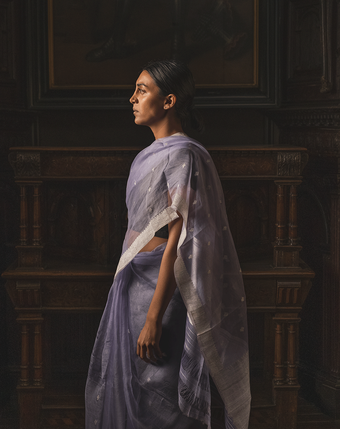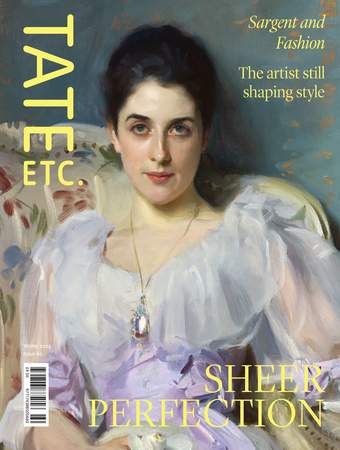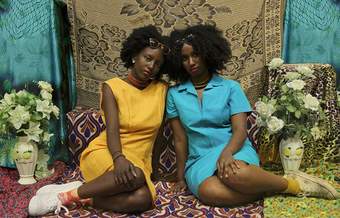
In Sutapa Biswas’s film Lumen 2021, the main character wears her mother’s once favourite, now antique sari
© Sutapa Biswas. All Rights Reserved. DACS 2023
My first encounter with art was watching my mother, framed by natural light, as she walked across an open space dressed in her sari. It felt like watching a moving sculpture that was full of beauty, mystery and intensity. It was filmic.
My mother’s saris – patterned, delicate, made from silks or cotton mixes – were a constant in my life. I learned about the different states of India, where I was born and where my family came from, not from my schooling in England where I moved in 1966, aged four, but through the variety of saris my mother wore. Each weave, palette, pattern and embroidery is distinctive to a specific region, and carries its own history.
My mother’s favourite sari at the time was made of a fine blue silk particular to the delta region of the Ganges. To my mind’s eye it had a quality that seemed to reflect the colour of the silt-ridden sea as we departed Bombay by ship. On one occasion, I witnessed my mother standing in front of her window as she read a letter from home written on a blue aerogram. Wearing that sari, her body silhouetted by the incoming light, she quietly wept.
When I came across Johannes Vermeer’s painting Woman in Blue Reading a Letter c.1663 at the age of about five, it took me back to this moment. Then, years later, as an art student, I encountered Vermeer’s painting again. Through research, I discovered that he made this piece during a period of colonial extraction in India by the Dutch East India Company. I realised that the blue pigment made from lapis lazuli likely came from a region that was formerly recognised as being part of the Indian subcontinent, now known as Afghanistan. As with my earlier artwork Untitled (Woman in Blue Weeping ) 1996, originally installed at University College London where it overlooked the preserved remains of the philosopher Jeremy Bentham, my new short film Lumen 2021 draws on enmeshed histories dating back to the 1600s – and that memory of my mother. In one of the final scenes of Lumen, the main character appears wearing her now antique blue silk sari.
I also remember being taken to the cinema by my parents after we came to England. Missing home, my parents would seize any opportunity to see classic Indian films at screenings around London. Although I was too young to understand the plots, I recall feeling awestruck by seeing larger-than-life brown bodies projected onto the flat screen – and, looking through this shaft of light that created these gigantic presences, I was equally mesmerised by the tiny flecks of dust caught in this ethereal space. This was another childhood experience that shaped the texture of my work.
In my early adult life, I realised that I was drawn in equal measure to the opposing relationships to time embodied by film and drawing. Film existed as a tangible celluloid structure that came to life through its fleeting interface with light. By contrast, drawing was a permanent presence arrived at through the temporal, bodily act of mark making. Working across both these mediums (and the spectrum between) has enabled me to explore the complexities of racial and gendered power relations born out of entangled colonial histories in a way that has poetic resonance.
Sutapa Biswas’s film Kali 1983–5 and her mixed-media artwork Housewives with Steak-Knives 1985 are included in Women in Revolt! until 7 April 2024.
Sutapa Biswas is an artist who lives in London.




